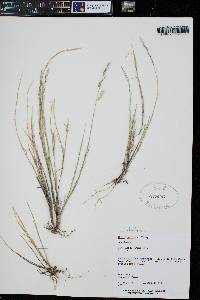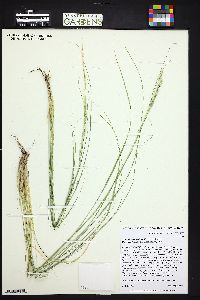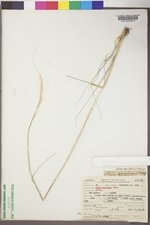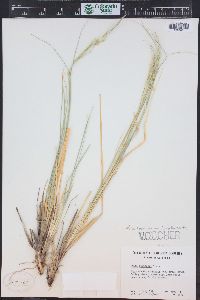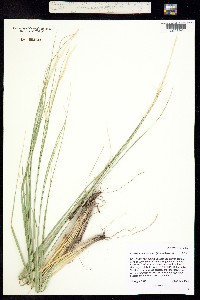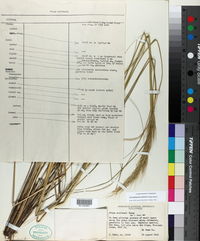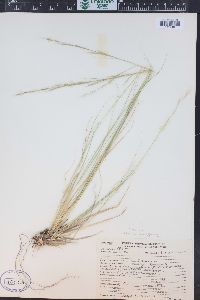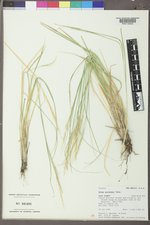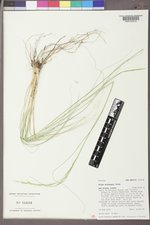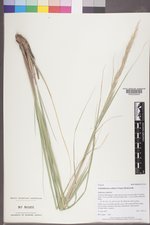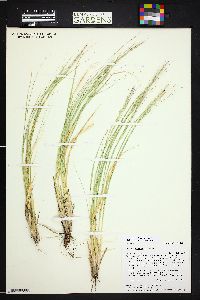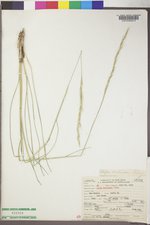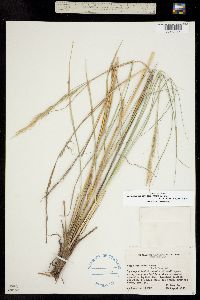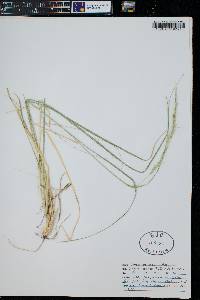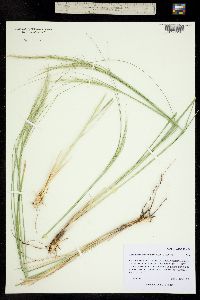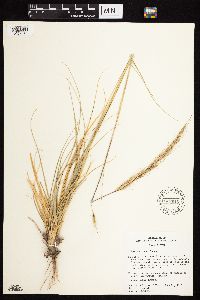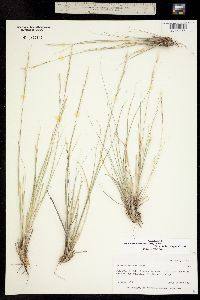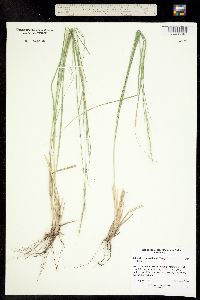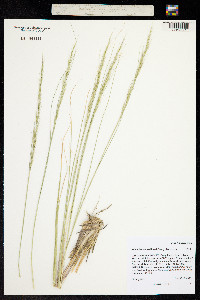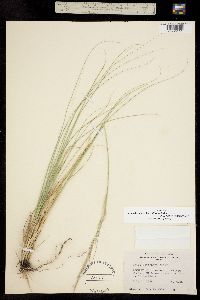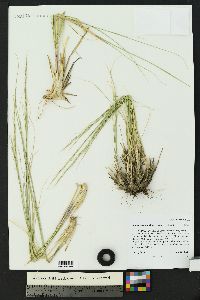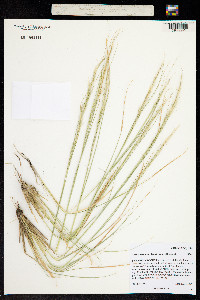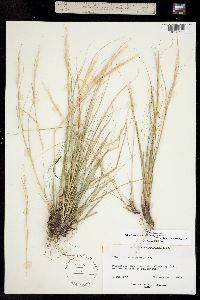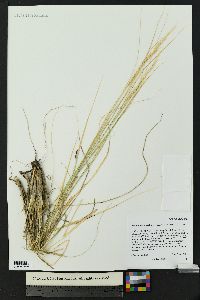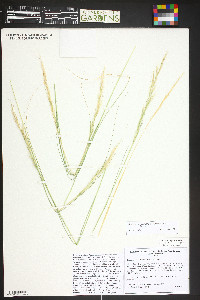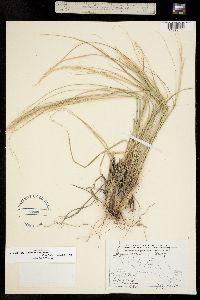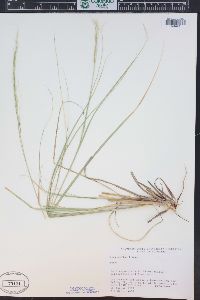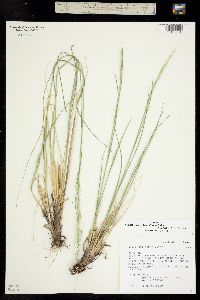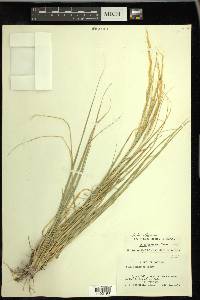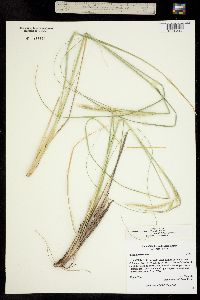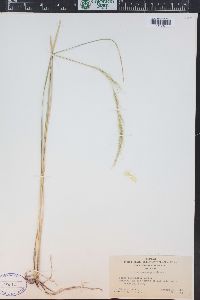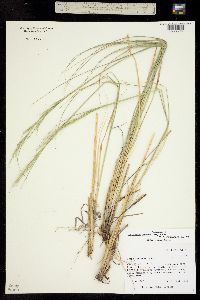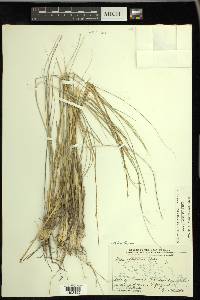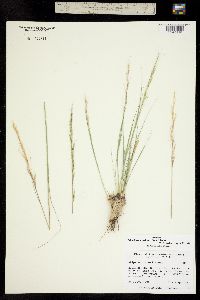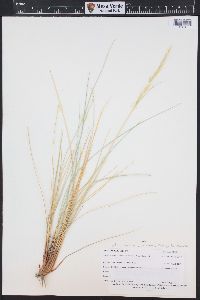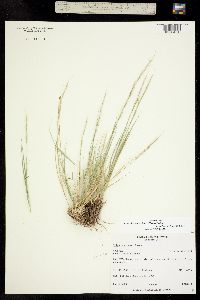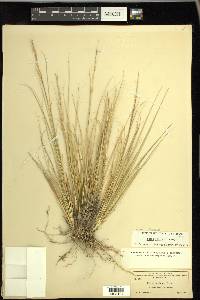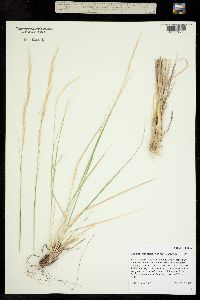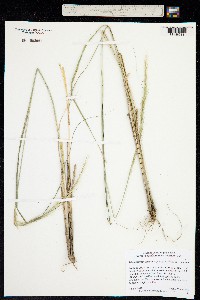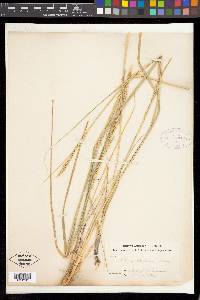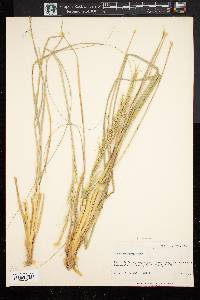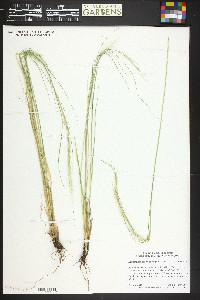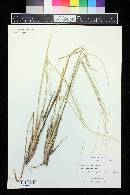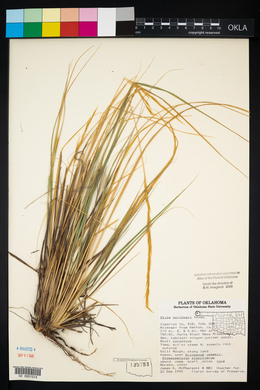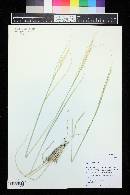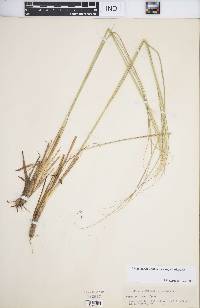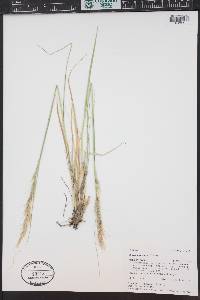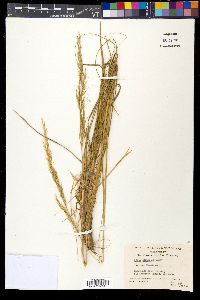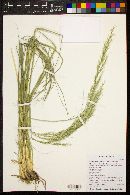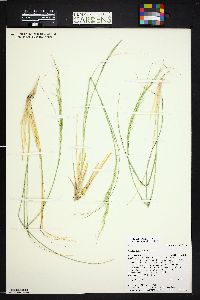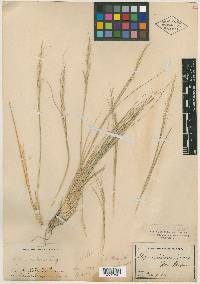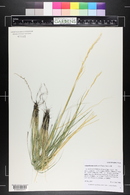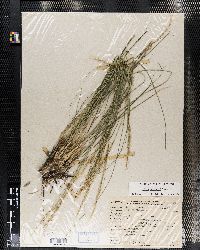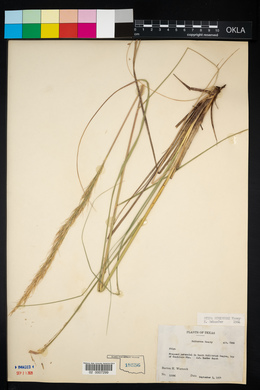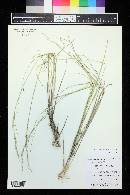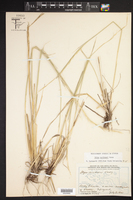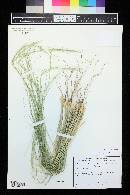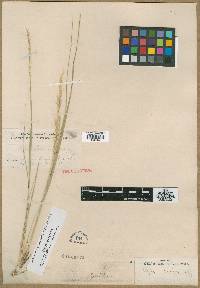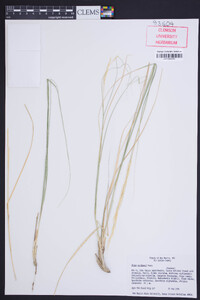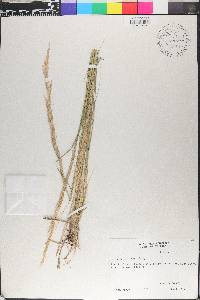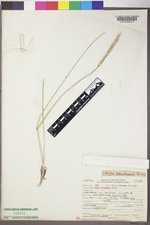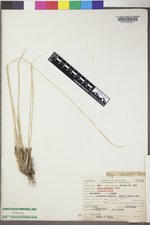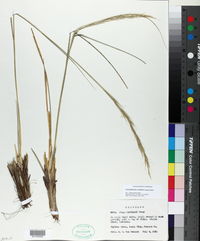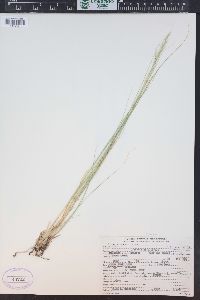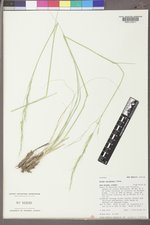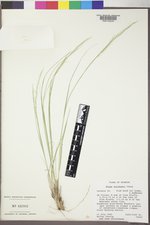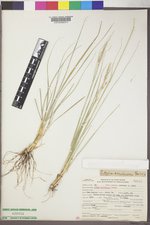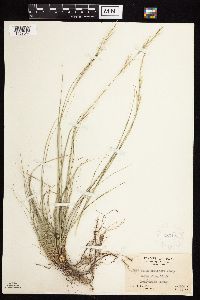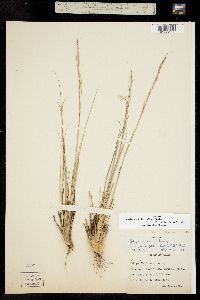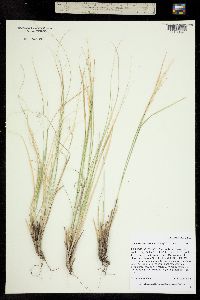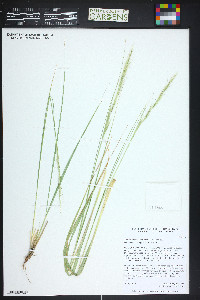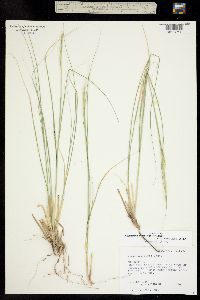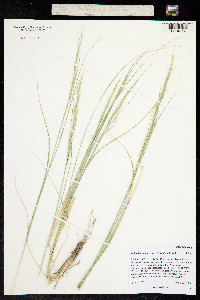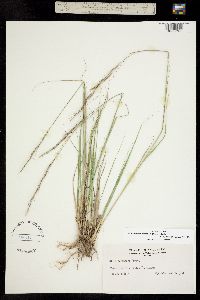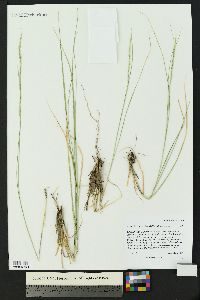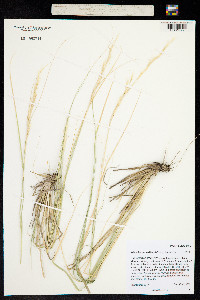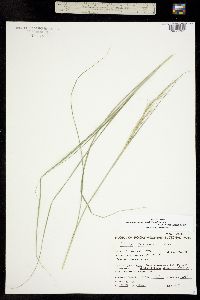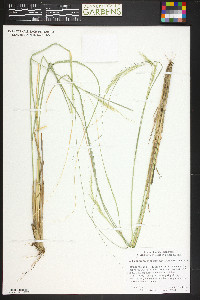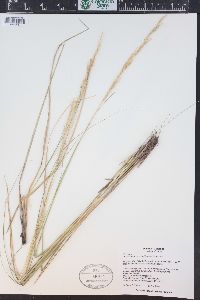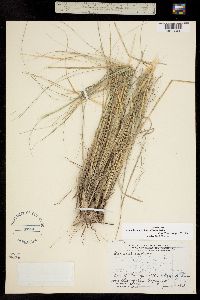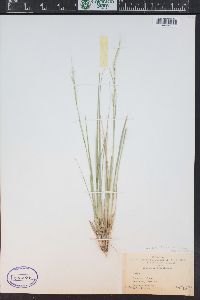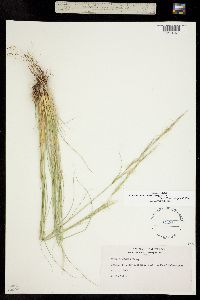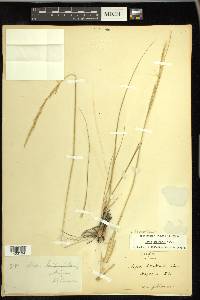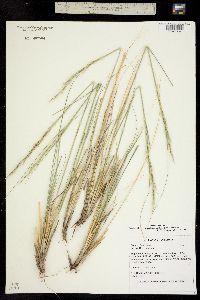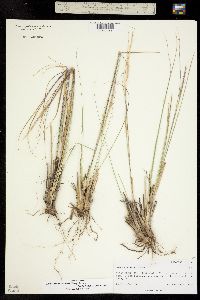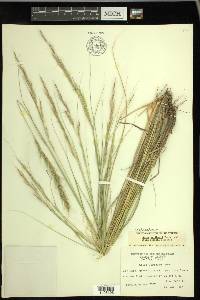Achnatherum scribneri
|
|
|
|
Family: Poaceae
Scribner needlegrass, more...Scribner's Rice Grass, Scribner's needlegrass, Scribner's Needlegrass
[Stipa scribneri Vasey] |
Plants cespitose, not rhizom-atous. Culms 25-90 cm tall, 0.5-1.6 mm thick, glabrous; nodes 3. Basal sheaths becom-ing flat and papery, margins ciliate distally; collars glabrous, with tufts of hair on the sides, hairs on the basal leaves to 1.5 mm, hairs on the flag leaves 1-2.5 mm; basal ligules 0.3-0.8 mm, truncate, erose, ciliate, cilia 0.2-0.4 mm; upper ligules to 1.5 mm, asymmetric, obliquely truncate for most of their width, abruptly longer on 1 side; blades to 30 cm long, 2-5 mm wide, flat or involute, long-tapering. Panicles 7-21 cm long, 0.5-1 cm wide; branches appressed to ascending, straight. Lower glumes 10-17 mm long, 0.7-1.2 mm wide, exceeding the upper glumes by 2.5-4.5 mm, apices tapering, often slightly recurved; florets 6-9.5 mm long, 0.6-1.1 mm thick, fusiform, terete, widest at or below midlength; calluses 0.5-1.5 mm, sharp; lemmas evenly hairy, hairs at midlength to 1 mm, apical hairs 2-3 mm, ascending, apical lobes 0.3-0.5 mm; awns 13-25 mm, persistent, usually once-geniculate, first segment scabrous, terminal segment straight; paleas 2.5-3.5 mm, 1/3-1/2 as long as the lemmas, pubescent, hairs not exceeding the apices, apices rounded; anthers 3-5 mm, dehiscent, not penicillate. Caryopses 5-6 mm, fusiform. 2n = 40. Achnatherum scribneri grows on rocky slopes, in pinyon-juniper and ponderosa pine associations at 1500-2700 m, from southeastern Wyoming through Colorado to Arizona, New Mexico, western Oklahoma, and Texas, and in Capital Reef National Park, Utah. At present, the Utah population appears to be disjunct from the species' primary range; this may reflect a lack of collecting. Achnatherum scribneri is similar to A. parishii, A. robustum, A. perplexum, and A. lobatum, differing from all of them in its sharp calluses. Dr. David Bogler, USDA NRCS PLANTS Database Pe rennials, Terrestrial, not aquatic, Stems nodes swollen or brittle, Stems erect or ascending, Stems caespitose, tufted, or clustered, Stems terete, round in cross section, or polygonal, Stem internodes hollow, Stems with inflorescence less than 1 m tall, Stems, culms, or scapes exceeding basal leaves, Leaves mostly basal, below middle of stem, Leaves mostly cauline, Leaves conspicuously 2-ranked, distichous, Leaves sheathing at base, Leaf sheath mostly open, or loose, Leaf sheath smooth, glabrous, Leaf sheath hairy at summit, throat, or collar, Leaf sheath and blade differentiated, Leaf blades linear, Leaf blades 2-10 mm wide, Leaf blades mostly flat, Leaf blades mostly glabrous, Ligule present, Ligule an unfringed eciliate membrane, Inflorescence terminal, Inflorescence a contracted panicle, narrowly paniculate, branches appressed or ascending, Inflorescence solitary, with 1 spike, fascicle, glomerule, head, or cluster per stem or culm, Flowers bisexual, Spikelets pedicel late, Spikelets dorsally compressed or terete, Spikelet less than 3 mm wide, Spikelets with 1 fertile floret, Spikelets solitary at rachis nodes, Spikelets all alike and fertille, Spikelets bisexual, Spikelets disarticulating above the glumes, glumes persistent, Spikelets disarticulating beneath or between the florets, Rachilla or pedicel glabrous, Glumes present, empty bracts, Glumes 2 clearly present, Glumes equal or subequal, Glumes equal to or longer than adjacent lemma, Glumes 3 nerved, Lemma coriaceous, firmer or thicker in texture than the glumes, Lemma 5-7 nerved, Lemma body or surface hairy, Lemma apex acute or acuminate, Lemma distinctly awned, more than 2-3 mm, Lemma with 1 awn, Lemma awn 1-2 cm long, Lemma awned from tip, Lemma awn twisted, spirally coiled at base, like a corkscrew, Lemma awn twice geniculate, bent twice, Lemma margins inrolled, tightly covering palea and caryopsis, Lemma straight, Callus or base of lemma evidently hairy, Callus hairs shorter tha n lemma, Lemma surface pilose, setose or bristly, Palea present, well developed, Palea membranous, hyaline, Palea shorter than lemma, Stamens 3, Styles 2-fid, deeply 2-branched, Stigmas 2, Fruit - caryopsis, Caryopsis ellipsoid, longitudinally grooved, hilum long-linear.
FNA 2007, Ann. Checklist GCNP 1987 Common Name: Scribner needlegrass Duration: Perennial Nativity: Native Lifeform: Graminoid General: Tuft-forming perennial bunchgrass to 90 cm tall, with a panicle inflorescence partly enfolded in the uppermost sheath and with awns 2-3 cm long. Vegetative: Plants in clumps, not rhizomatous, stems 25-90 cm tall, 1 mm thick, glabrous, basal sheaths flat and papery, collars with tufts of hairs on the sides, hairs on leaves 1-2 mm long, basal ligules <1 mm long, truncate and ciliate, upper ligules <2 mm long, l Inflorescence: Panicles 7-21 cm long, , 0.5-1 cm wide, branches lie close to the stem, straight; lower glumes 1-1.5 cm long, 1 mm wide, longer than the upper glumes by 2-4 mm; florets 0.5-1 cm long, 1 mm thick, calluses 1 mm, sharp; lemmas hairy with hairs 1-3 mm, awns 1-3 cm, usually bent once, terminal segment straight, paleas 2-3 mm, about half as long as the lemmas, pubescent, apices rounded, anthers 3-5 mm long. Ecology: Found on rocky slopes, in pi-on-juniper and ponderosa pine woodlands at 1500-2700 m. Flowers May-Sept. Distribution: Arizona, Colorado, Wyoming, Texas, and Oklahoma. Notes: Is similar to A. parishii, A. robustum, A. perplexum, and A. lobatum, but can be distinguished from them by its sharp calluses. Ethnobotany: Unknown Etymology: Achnatherum means awned scale or awn-scaled and comes from Greek word achne for chaff or glume and ather meaning stalk or barb; scribneri is named after Frank Lamson-Scribner (1851-1938), who was the first USDA scientist to study diseases of economic plants and was an expert on grasses. Editor: Lkearsley, 2012 |


